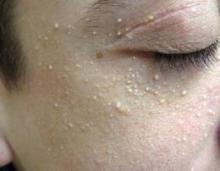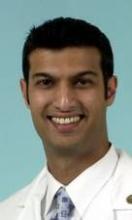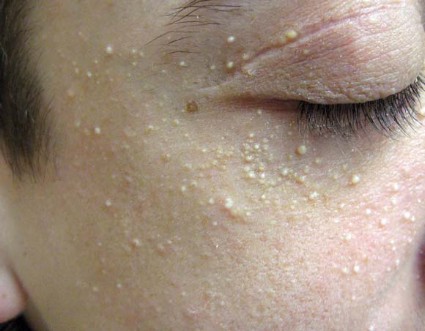User login
ORLANDO – Loeys-Dietz syndrome is a rare genetic disease that can be life threatening if not caught early, said Dr. Milan J. Anadkat.
Children with the connective tissue disorder often present with up to 50 or more milia, as well as velvety and translucent skin, easy bruising, varicose veins, and atrophic scars. Craniosynostosis, cleft lip or palate, and ocular hypertelorism are among the potential craniofacial abnormalities.
"If you have a patient less than 10 years old who has these milia and craniofacial features, they need to be genetically tested," said Dr. Anadkat of the division of dermatology at Washington University in St. Louis.
The experience at Washington University includes at least 25 children with Loeys-Dietz syndrome. Exposure to multiple patients with such a relatively rare disorder is an advantage of practicing dermatology at a large academic center, Dr. Anadkat said at the annual meeting of the Florida Society of Dermatology and Dermatologic Surgery.
Loeys-Dietz syndrome, first described in 2005 by Dr. Bart Loeys and Dr. Hal Dietz, affects connective tissue throughout the body. There are different subtypes, receptor mutations, and phenotypes, but what is most remarkable is that 75% of cases present as de novo, spontaneous mutations.
"The importance of knowing about Loeys-Dietz syndrome has to do with the cardiovascular complications," he said. This autosomal dominant genetic disorder is part of the subset of aortic aneurysm syndromes that includes Marfan syndrome.
Aggressive cardiovascular disease, aortic dissection by the teenage years (or "decades earlier than what we see in Marfan syndrome"), and arterial tortuosity are among the serious, extracutaneous manifestations, said Dr. Anadkat. Because arterial tortuosity can occur anywhere in the body (not just around the heart), a total body vascular scan is warranted.
Presence of milia may facilitate an early distinction from Marfan syndrome. Other syndromes with milia to include in the differential diagnosis include Bazex-Dupré-Christol syndrome, Rombo syndrome, and Rasmussen syndrome.
Patients with Loeys-Dietz syndrome also can present with musculoskeletal anomalies such as joint laxity, club foot, pectus deformity, scoliosis, and cervical spine abnormalities. "This could explain how, for decades, we saw patients with Marfanlike abnormalities who did not have a genetic test positive for Marfan syndrome," Dr. Anadkat said.
He and his associates published a report on four unrelated patients with Loeys-Dietz syndrome who developed milia in early childhood and reported increases in their number over time (Arch. Dermatol. 2011:147:223-6). Although more needs to be studied regarding specific mutations and phenotypes, each of these patients had the same TGFBR2 mutation.
More information on the disease is available online at the Loeys-Dietz Foundation website.
Dr. Anadkat said that he had no relevant financial disclosures.
ORLANDO – Loeys-Dietz syndrome is a rare genetic disease that can be life threatening if not caught early, said Dr. Milan J. Anadkat.
Children with the connective tissue disorder often present with up to 50 or more milia, as well as velvety and translucent skin, easy bruising, varicose veins, and atrophic scars. Craniosynostosis, cleft lip or palate, and ocular hypertelorism are among the potential craniofacial abnormalities.
"If you have a patient less than 10 years old who has these milia and craniofacial features, they need to be genetically tested," said Dr. Anadkat of the division of dermatology at Washington University in St. Louis.
The experience at Washington University includes at least 25 children with Loeys-Dietz syndrome. Exposure to multiple patients with such a relatively rare disorder is an advantage of practicing dermatology at a large academic center, Dr. Anadkat said at the annual meeting of the Florida Society of Dermatology and Dermatologic Surgery.
Loeys-Dietz syndrome, first described in 2005 by Dr. Bart Loeys and Dr. Hal Dietz, affects connective tissue throughout the body. There are different subtypes, receptor mutations, and phenotypes, but what is most remarkable is that 75% of cases present as de novo, spontaneous mutations.
"The importance of knowing about Loeys-Dietz syndrome has to do with the cardiovascular complications," he said. This autosomal dominant genetic disorder is part of the subset of aortic aneurysm syndromes that includes Marfan syndrome.
Aggressive cardiovascular disease, aortic dissection by the teenage years (or "decades earlier than what we see in Marfan syndrome"), and arterial tortuosity are among the serious, extracutaneous manifestations, said Dr. Anadkat. Because arterial tortuosity can occur anywhere in the body (not just around the heart), a total body vascular scan is warranted.
Presence of milia may facilitate an early distinction from Marfan syndrome. Other syndromes with milia to include in the differential diagnosis include Bazex-Dupré-Christol syndrome, Rombo syndrome, and Rasmussen syndrome.
Patients with Loeys-Dietz syndrome also can present with musculoskeletal anomalies such as joint laxity, club foot, pectus deformity, scoliosis, and cervical spine abnormalities. "This could explain how, for decades, we saw patients with Marfanlike abnormalities who did not have a genetic test positive for Marfan syndrome," Dr. Anadkat said.
He and his associates published a report on four unrelated patients with Loeys-Dietz syndrome who developed milia in early childhood and reported increases in their number over time (Arch. Dermatol. 2011:147:223-6). Although more needs to be studied regarding specific mutations and phenotypes, each of these patients had the same TGFBR2 mutation.
More information on the disease is available online at the Loeys-Dietz Foundation website.
Dr. Anadkat said that he had no relevant financial disclosures.
ORLANDO – Loeys-Dietz syndrome is a rare genetic disease that can be life threatening if not caught early, said Dr. Milan J. Anadkat.
Children with the connective tissue disorder often present with up to 50 or more milia, as well as velvety and translucent skin, easy bruising, varicose veins, and atrophic scars. Craniosynostosis, cleft lip or palate, and ocular hypertelorism are among the potential craniofacial abnormalities.
"If you have a patient less than 10 years old who has these milia and craniofacial features, they need to be genetically tested," said Dr. Anadkat of the division of dermatology at Washington University in St. Louis.
The experience at Washington University includes at least 25 children with Loeys-Dietz syndrome. Exposure to multiple patients with such a relatively rare disorder is an advantage of practicing dermatology at a large academic center, Dr. Anadkat said at the annual meeting of the Florida Society of Dermatology and Dermatologic Surgery.
Loeys-Dietz syndrome, first described in 2005 by Dr. Bart Loeys and Dr. Hal Dietz, affects connective tissue throughout the body. There are different subtypes, receptor mutations, and phenotypes, but what is most remarkable is that 75% of cases present as de novo, spontaneous mutations.
"The importance of knowing about Loeys-Dietz syndrome has to do with the cardiovascular complications," he said. This autosomal dominant genetic disorder is part of the subset of aortic aneurysm syndromes that includes Marfan syndrome.
Aggressive cardiovascular disease, aortic dissection by the teenage years (or "decades earlier than what we see in Marfan syndrome"), and arterial tortuosity are among the serious, extracutaneous manifestations, said Dr. Anadkat. Because arterial tortuosity can occur anywhere in the body (not just around the heart), a total body vascular scan is warranted.
Presence of milia may facilitate an early distinction from Marfan syndrome. Other syndromes with milia to include in the differential diagnosis include Bazex-Dupré-Christol syndrome, Rombo syndrome, and Rasmussen syndrome.
Patients with Loeys-Dietz syndrome also can present with musculoskeletal anomalies such as joint laxity, club foot, pectus deformity, scoliosis, and cervical spine abnormalities. "This could explain how, for decades, we saw patients with Marfanlike abnormalities who did not have a genetic test positive for Marfan syndrome," Dr. Anadkat said.
He and his associates published a report on four unrelated patients with Loeys-Dietz syndrome who developed milia in early childhood and reported increases in their number over time (Arch. Dermatol. 2011:147:223-6). Although more needs to be studied regarding specific mutations and phenotypes, each of these patients had the same TGFBR2 mutation.
More information on the disease is available online at the Loeys-Dietz Foundation website.
Dr. Anadkat said that he had no relevant financial disclosures.
EXPERT ANALYSIS FROM THE ANNUAL MEETING OF THE FLORIDA SOCIETY OF DERMATOLOGY AND DERMATOLOGIC SURGERY


